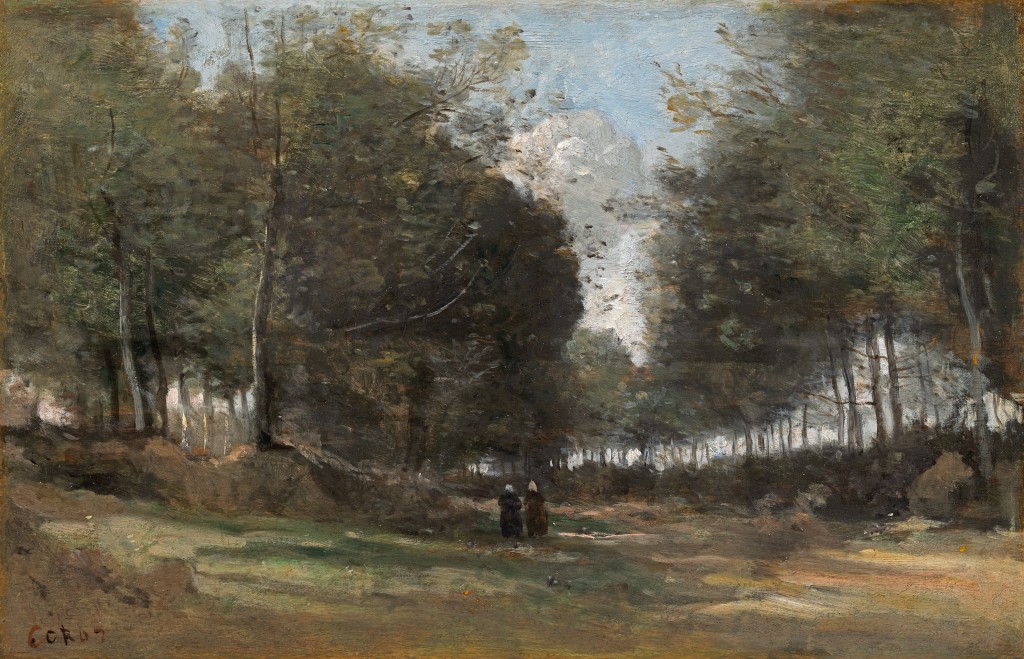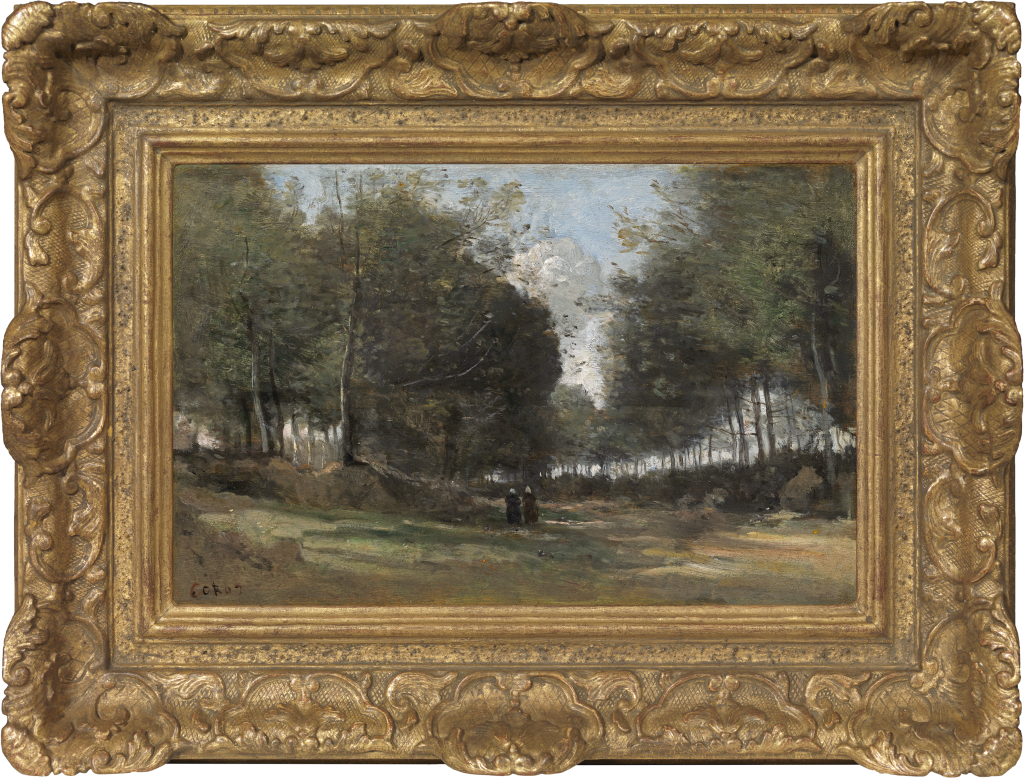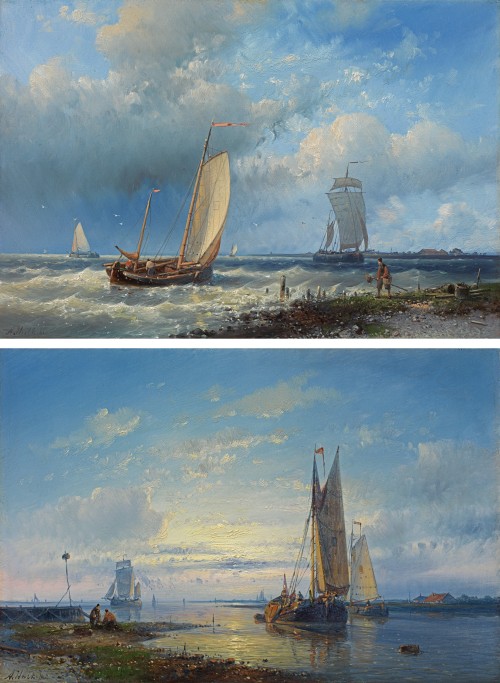JEAN BAPTISTE CAMILLE COROT
Paris 1796 - 1875 Ville d'Avray
Ref: BY 148
Ville d'Avray, allee sous bois
Signed lower left: Corot
Oil on panel: 9¼ x 14 in / 23.5 x 35.6 cm
Frame Size: 14¾ x 19 3/8 in / 37.5 x 49.2
Painted circa 1830-40
Provenance:
Hôtel Drouot, 6th April 1876, lot 2 (FFr.500)
M de Saint-Albin Collection
Eugène Le Roy Collection
Tooth, London, 1910, inv. no.2230
Sotheby’s New York, 26th May 1983, lot 30
Galerie Dr Hans-Peter Bühler, Munich;
from whom acquired in 1985 by a private collector, Switzerland
Literature:
Alfred Robaut, L’Oeuvre de Corot, Paris 1905, vol. II, pp.98-99, no.279, illus.
Martin Dieterle and and Claire Lebeau have confirmed that this is an autograph work by Jean-Baptiste-Camille Corot
‘Beauty in art consists of a truthfulness in the impression we have received from an aspect of nature...the real is one part of art; the sentiment completes it’, Corot declared in 1856. Just as Boudin was revered by the Impressionists for his experiments in capturing coastal light and atmosphere, so Corot was regarded by them as the supreme exponent of naturalistic, plein-air landscape painting.
Ville d’Avray, near Sèvres, was an inspiration throughout Corot’s career: the painter and collector Moreau-Nelaton noted that ‘Providence created Ville-d’Avray for Corot, and Corot for Ville-d’Avray’. His father, a prosperous milliner, bought a handsome eighteenth century villa there in 1817, the same year that Corot began painting classes at the Académie Suisse in Paris. Corot inherited the villa after his father’s death and loved to immerse himself in the familiar scene of gentle, wooded hills, ponds and meandering streams.
In the 1830s, when this painting was made, Corot was influenced by seventeenth century Dutch art, particularly the work of Jacob van Ruisdael (1628/9-1682), who combined realism with emotional expressiveness in his evocation of nature. The sense of being inside a wood, a theme often treated by Ruisdael and his pupil Meindert Hobbema (1638-1709), is explored by Corot here. The deep green of the foliage is enlivened by touches of ochre and gold to suggest sunlight shimmering through the canopy. The path is in shadow, but a band of light glimpsed beneath the lowest branches hints at a radiant landscape beyond, with a sky fretted with cumulus clouds. Corot’s genius lies in his organization of tones and masses of light and shadow to make a serene and alluring composition. The two peasant women walking along the path, deep in conversation, provide a harmonious human presence. They are dwarfed by the trees, but completely at ease in the landscape. Vincent van Gogh praised the ‘quietness, mystery and peace’ of Corot’s paintings.
The woods and forests of northern France played an important part in the development of naturalistic, plein-air painting in the mid-nineteenth century. Corot made a number of paintings in the Forest of Fontainebleau, about forty miles south-east of Ville d’Avray, in the 1820s and 30s. Fontainebleau, chênes noirs du Bas-Bréau, c.1831-33 (Metropolitan Museum of Art, New York) is another subtle exploration of light on trees. Artists made their base in the villages of Barbizon and Chailly, setting forth into the forest to capture nature with directness and spirit. The painter François Français recalled their joie de vivre: ‘Nous y étions une bande et qui n’engendrait pas mélancholie! Diaz, Rousseau, Barye, Decamps, Corot. Des dames aussi naturellement! Ah! Quelle gaieté, mes amis, quels rires!’[1] Corot later became a friend and mentor of another Barbizon artist, Charles-François Daubigny (1817-1878), with whom he undertook a painting tour of Switzerland.
JEAN-BAPTISTE-CAMILLE COROT
Paris 1796 - 1875 Ville d’Avray
Born into a Parisian merchant’s family, Jean-Baptiste-Camille Corot renounced his commercial heritage in order to pursue his vocation as a painter. Despite his family’s opposition, he received an allowance from his father that enabled him to study first with Michallon, and then with Bertin, both neo-classical landscape painters.
In 1825 Corot made his first visit to Italy. During the three years he spent there he painted many of his most spontaneous plein air masterpieces, remarkable for their fidelity to nature, a classical concern with form and the precise observation of tonal values. In 1834 and 1843, he made two more visits to Italy, painting in Rome, Florence and Venice.
Corot also painted more academic and finished works which he considered more suitable for the Paris Salon, where he exhibited from 1827. He received a second-class medal at the Salon in 1833 and was awarded the Légion d’Honneur in 1846. During the 1830s, Corot was influenced by Dutch seventeenth century artists, especially Jacob van Ruisdael. Apart from this Dutch phase, however, his paintings tended to convey a more idealised concept of nature, expressed in a Claudian vein, which often included literary, allegorical or mythological subjects.
Corot travelled extensively throughout France, painting along the Channel coast and in Fontainebleau. His most cherished spot was at Ville d’Avray near Versailles, where his parents had purchased a villa amidst a landscape that was of particular aesthetic appeal. He visited Holland in 1854 and England in 1862.
Corot’s increasingly idealised concept of landscape resulted in the all-pervasive lyricism that characterised his late work. He entitled these paintings souvenirs, which were essentially nostalgic distillations of his visual experience, admired for their delicate, dreamlike quality. In 1856 Corot wrote: ‘Beauty in art consists of a truthfulness in the impression we have received from an aspect of nature... the real is one part of art; the sentiment completes it’. It was the diaphanous, twilight effects of his paintings that epitomized such sentiment and greatly appealed to the prevalent neo-Rococo taste.
From the late 1840s, Corot became acquainted with the Barbizon painters, particularly Daubigny, Millet and Rousseau, with whom he painted and studied the new art of photography. His interest in naturalism and an unerring fidelity to his own personal vision earned him the esteem of many younger artists, including Harpignies, Lépine and Pissarro; it was they who named him with reverence Père Corot.
[1] Quoted in Daniel Baud-Bovy, Corot, Geneva 1957, p.36 and Paris, Grand Palais/Ottawa, Museum of Fine Arts/New York, Metropolitan Museum of Art, Corot 1796-1875, 1996-7, p.138.
















